Yard Force Gas Pressure Washer (YF3100ES-R): Product Review
We independently evaluate all recommended products and services. If you click on links we provide, we may receive compensation.
The first electric start pressure on the market. An awesome machine!
Available on Amazon
Buy ItDo you have a concrete walkway, driveway or patio? How about wood, brick, vinyl, or aluminum siding on your house? A fence or deck? A tool shed? Or what about a concrete slab in your garage? Gutters full of leaves? A car? All of these things get filthy and need regular cleaning. A garden hose doesn’t have the power to make them sparkle, and, if you’re like me, the very thought of scrubbing them by hand keeps you from ever getting around to even starting the job.
If you have most of the things I listed above that need to be cleaned at your house (like I do at mine), the Yard Force Gas Pressure Washer (YF3100ES-R) might be the perfect pressure washer for you.
The Yard Force YF3100ES-R gas pressure washer is a powerful beast of a unit, using the latest Briggs & Stratton 875EXi SeriesTM engine and featuring the only wireless remote start in the pressure washer world. Beyond that, it carries the Yard Force name, a company that has become synonymous with one-stop product solutions for electric and gas outdoor power equipment using advanced technology and designs at competitive prices.
Based on the performance testing I’ve done with this unit over the last month, it will now join my permanent stable of must-have tools.
Specifications
- Engine: Briggs & Stratton 875EXi SeriesTM single cylinder, 4-stroke, air-cooled, OHV (Overhead Valve) engine with 190cc displacement featuring Just Check & AddTM oil reservoir (never change oil, just check and add as needed), ReadyStart® (no priming), and S2 Starting Guarantee assuring the unit will start on the first two pulls.
- Fuel capacity: 1.06 quarts
- Oil capacity: 16-20 oz.
- Working Pressure: 3100 PSI
- Flow Rate: 2.4 GPM
- High-Pressure Hose Length: 25’ as equipped. You can purchase additional hoses up to 100’ in length.
- Wand: Metal wand with quick-connect tip
- Nozzles: 00, 150, 400, and soap nozzle
- Detergent tank capacity: 1 gallon
- Wheels: Two 12″ hard plastic rear wheels
- Storage: Built in storage for nozzles and high-pressure hose
- Extra/Bonus Features: 1st wireless start pressure washer on the market, powered by 20V lithium ion battery (battery and charger included) that provides 75 starts per charge; keyless remote starting fob with a 125’ range
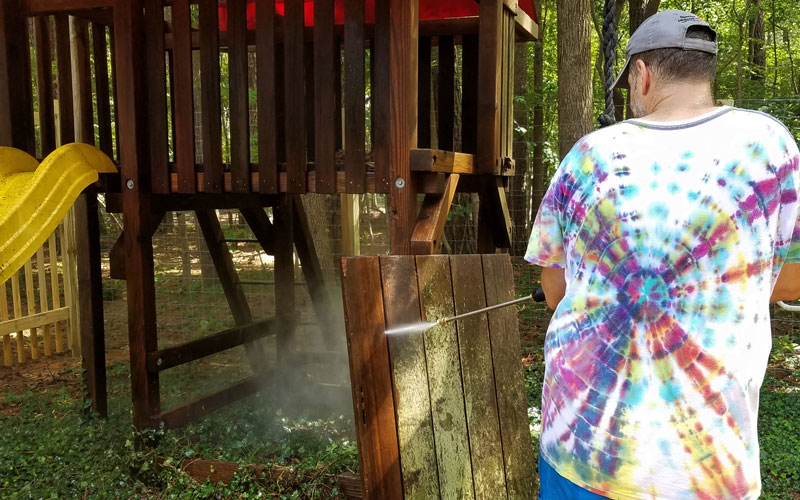
The pressure washer removing years of mold, mildew, and pollen
Packaging
The Yard Force YF3100ES-R gas pressure washer arrived in a tidy cardboard box with all of the contents securely nestled inside. Colorful graphics told me what to expect inside the box, and after a quick check, I found everything to be in order.
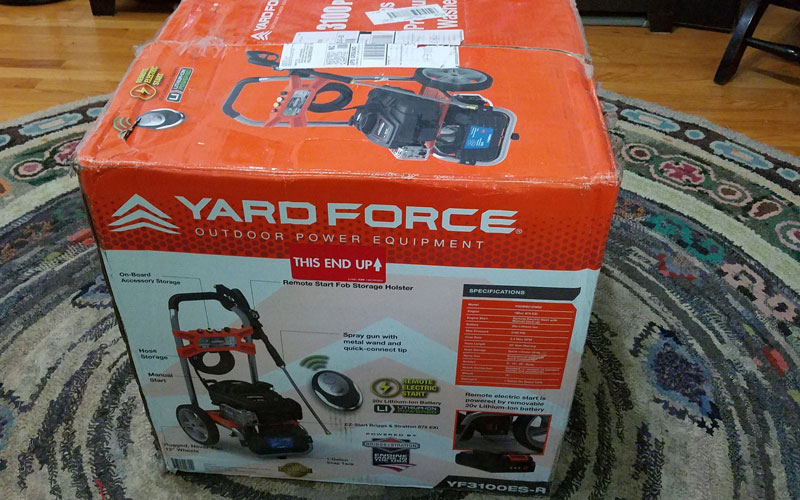
The box and contents arrived in great shape
Assembly
Even as a storm kicked up outside, I couldn’t wait to put the Yard Force pressure washer together. So I cut open the box (per the instructions) in my family room and laid out the contents.
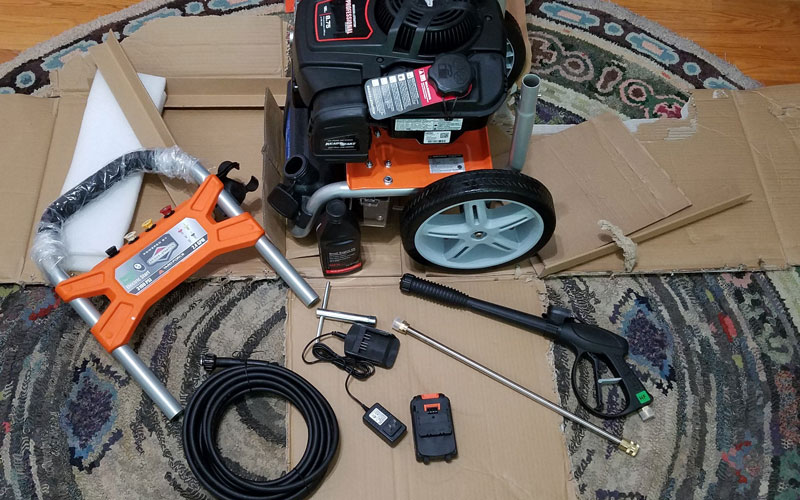
Everything you need is inside the box
Here’s what you will find inside:
- Yard Force pressure washer unit 95% assembled (wheels, engine, base, etc.)
- Pressure washer hose
- Pressure washer wand (in two parts)
- Sparkplug wrench
- 16 oz. of oil
- Slide-in handle (containing the 4 included nozzle tips)
- 2 manuals (operator manual and Briggs & Stratton engine manual)
- 20V lithium rechargeable battery and charger
The assembly process is clearly spelled out in the operator manual, but here is a quick overview of what to expect.
First, I plugged in the battery charger and slid the battery into the charger unit. If you’ve ever owned a battery-powered tool, you know this procedure.
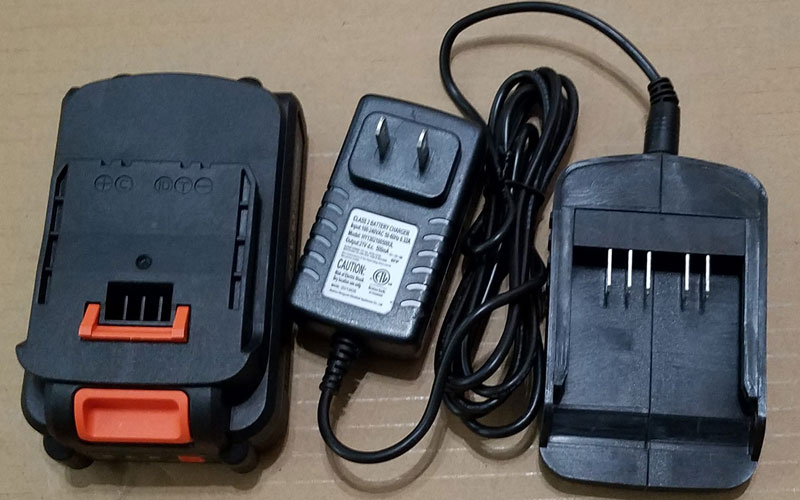
battery and battery charger
When the battery is fully charged, the indicator light will go from flashing green to a steady green. You can press the convenient battery charge level indicator on the battery to show how much battery charge you have remaining during use.
Next, I assembled the handle. Simply line up the hollow, tubular handle posts with the corresponding slots on the back of the frame. Insert both sides of the handle while depressing the metal locks. Push down until both sides lock into place. Release the metal locks. You’re done.
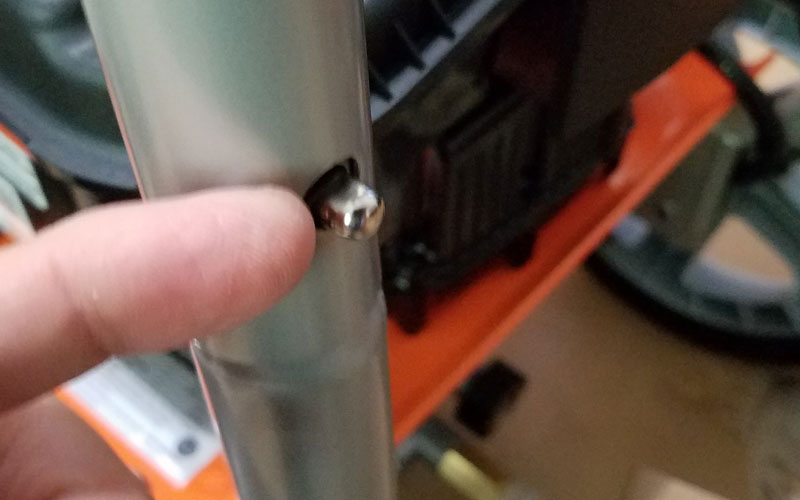
Align and slide the tubular handle onto the frame posts until both sides click into place
The tool comes with a 25’ foot hose with identical threaded female receptacles.
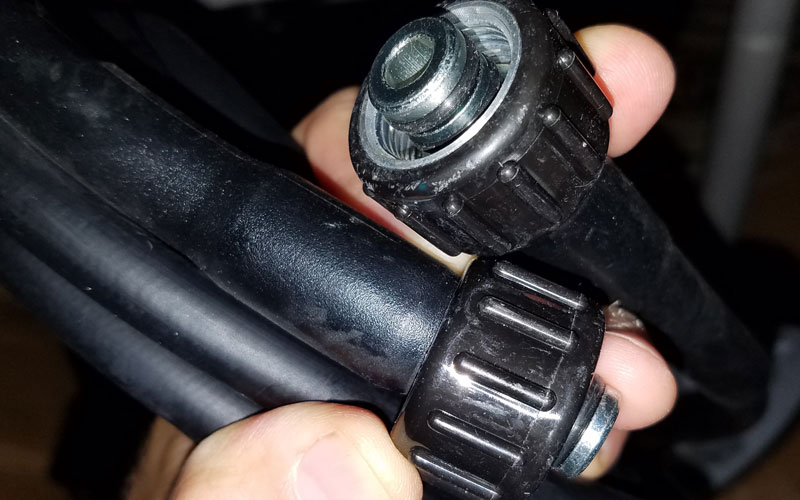
The ends of the included threaded hose are identical
One end attaches to the bottom of the unit (from the pump outlet) and the other end threads onto the wand. Line up the male ends into the female receptacles and then screw both ends tight.
To prolong the life of the black rubber gaskets on the pressure coupler, add a dab of petroleum jelly each time you attach the hose. You can do the same when attaching your garden hose to the water inlet to give you a better seal.
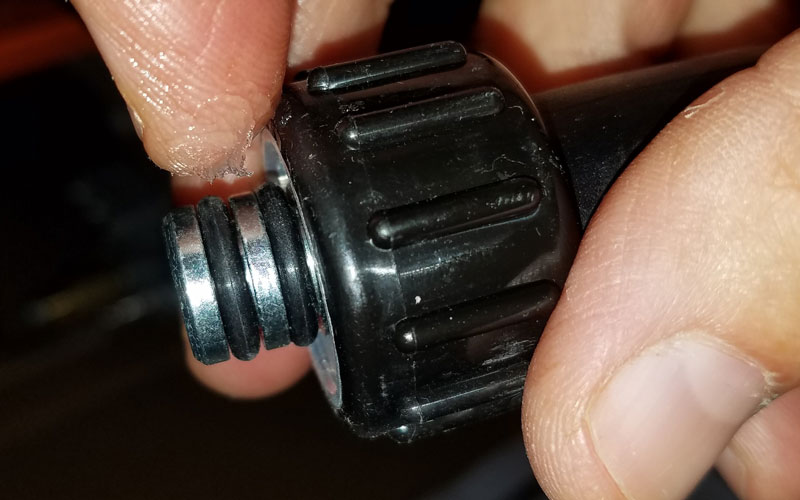
Each time you attach the pressure hose to the pump outlet and the wand, put a small amount of petroleum jelly on the black rubber gaskets to make them last longer and give you a better seal
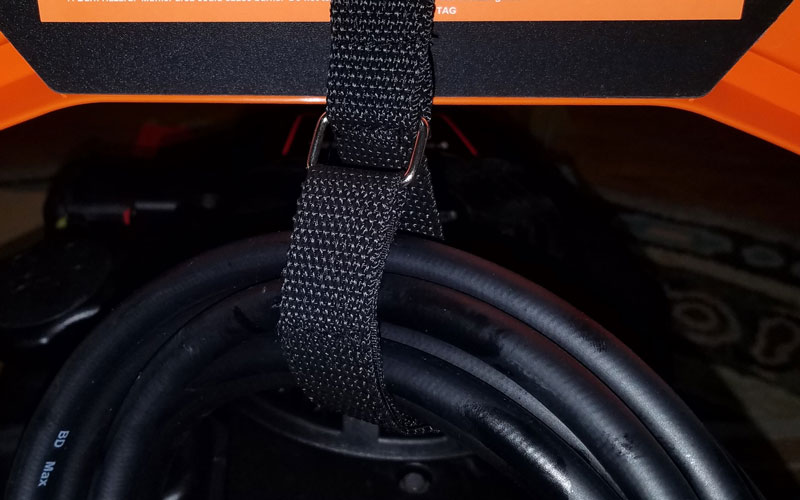
When not in use, store the hose at the back of the unit using the included hook-and-loop fastener
Engine and Starter Prep
The Briggs & Stratton engine runs on any unleaded gasoline. Personally, I prefer using gasoline without ethanol. Ethanol can cause gumming in the carburetor of small engines, and in some cases the use of an ethanol-mixed fuel can void a product warranty. I also use a fuel stabilizer in my gas can, adding the recommended amount to treat 5 gallons at a time. A stabilizer further fights gumming and is recommended to add to the gas tank when storing for more than 30 days. Since I never know if I’m done with a tool for the season, I just add it as a preventive measure.
Yard Force includes a 16 oz. bottle of oil which is added via the dipstick opening on top of the unit. While the crankcase can hold up to 20 oz, the manufacturer recommends adding 16 oz. only if you’ll be running the engine in hot weather where the oil will expand. Since the engine features the Just Check & AddTM oil reservoir, you never need to drain the oil. Instead, add any SAE 30 motor oil for 4-cycle engines as needed.
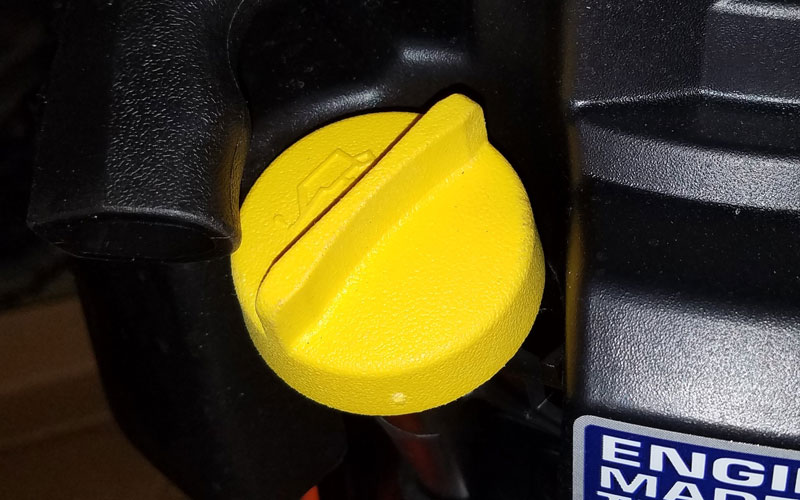
Unscrew the dipstick to add oil and to check the oil level
By now, the 20V lithium-ion battery should be fully charged. Remove it from the charger, and slide it into the battery compartment on the side of the pressure washer.
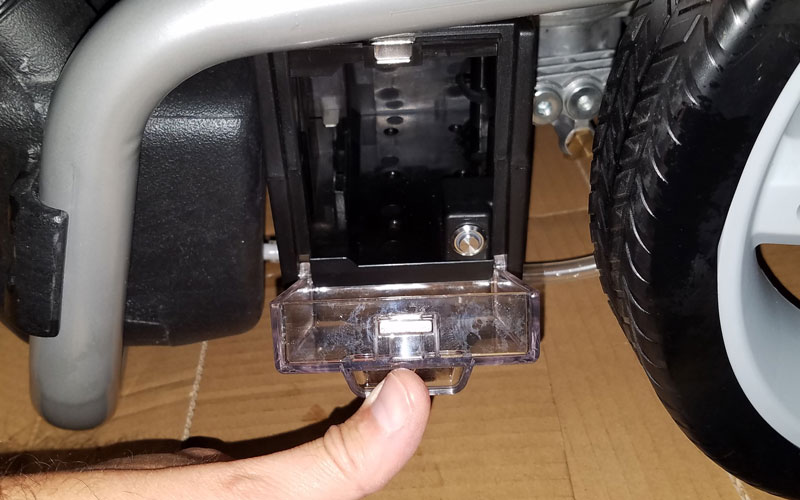
Lift the battery compartment door and slide the battery in until it clicks into place
Wireless Starting Capability
It’s time for the one-of-a-kind feature exclusive to this Yard Force pressure washer model: the wireless start! Once the battery is inserted, press the button on the bottom right of the battery compartment. It will flash green quickly. Then, remove the wireless key fob from its storage slot on the wand handle and place it next to the green light while pressing the STOP button on the fob for 3 seconds. Release. Now the key fob is paired with starter.
In case you’re wondering “Why would I ever want wireless starting capability on a pressure washer?” let me tell you why I like it:
- I never had to pull a cord to start the engine, although I did just to test the S2 Starting Guarantee from Briggs & Stratton that promised the engine will engage with one or two pulls (it does).
- The wireless start extends runtime and reduces fuel waste. Instead of running the engine nonstop while moving a hose or a ladder to a new position, I could easily shut off and turn on the engine so it burns fuel only when I am ready to get back to work
- Several times while I worked, my wife came out to talk to me while I stood on a ladder cleaning off some hard-to-reach places. At least, I assumed she was talking. All I saw was her mouth moving. Using the fob, I didn’t have to get off the ladder or even change positions. I shut off the engine remotely. When she was done talking, I got back to work without skipping a beat.
- While I never needed to use the remote start/stop for this purpose, I liked the idea of being able to stop the engine while far away from the machine. For example, if a small child went near the hot engine, I could shut it down quickly. This would be particularly handy if I stood 95’ away using a 100’ hose. Most other garden tools are “attached” to the users’ hands. When using a lawn mower, chainsaw, blower, hedger, or trimmer, you can shut them off instantly when needed. I liked the idea that I could do the same thing with the pressure washer if needed.
Start Your Engine!
If you want more detailed information about the equipped Briggs & Stratton engine, you can learn more on their website.
Once I got the unit assembled and the engine prepped, I couldn’t wait to put the Yard Force pressure washer through its paces.
Safety First
Let me suggest that you don’t skip over reading the operator manual. I’m usually the first person to break this rule, but in this case, I found the manual helpful. Also, steps have to be followed in a particular order to run the pressure washer properly.
If you read the manual, you’ll understand the importance of following safety measures to protect you and anything you might wish to wash. Without getting technical, the water comes out of the nozzle tip from the hose powered by the pump at a high enough rate and volume that it can dent your car while taking off the paint! So read the instructions. Don’t point the nozzle at anything except for your intended target. That means don’t spray the kids, your dog, or birds resting in trees. Wear safety goggles and consider wearing close-toed shoes if you’re spraying near your feet, like on a walkway.
Turning it On
To start the pressure washer, make sure the engine is switched to the ON position.
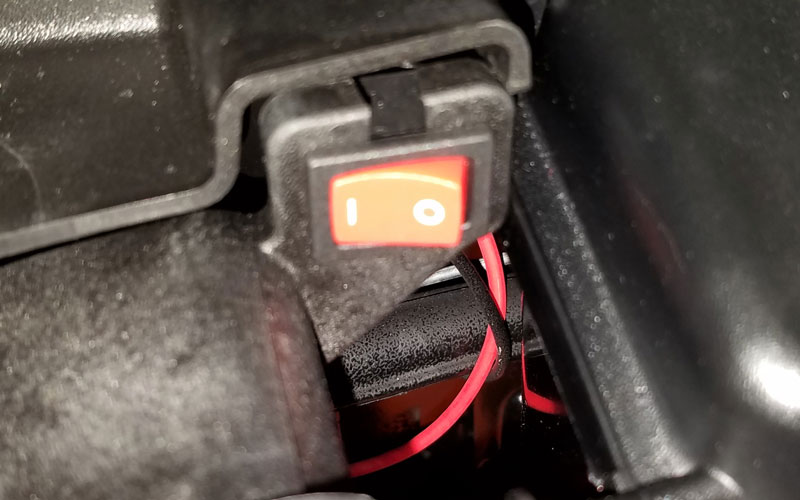
Turn the engine to the ON position (which is a solid vertical line like this)
Next, tighten the garden hose in the threaded end of the pump.
If you have not yet attached the pressure washer hose to the water output and the wand (remember to use petroleum jelly to lubricate the rubber gaskets), do so now.
Turn on the faucet from your garden hose to the pressure washer. Squeeze the trigger on the wand until water flows out the tip. Once the water flows from the tip, lift the plastic trigger lock into the LOCK position.
Choosing the Right Nozzle
Insert the best nozzle tip based on your project. The nozzles are attached conveniently in designated slots on the mounted handle.
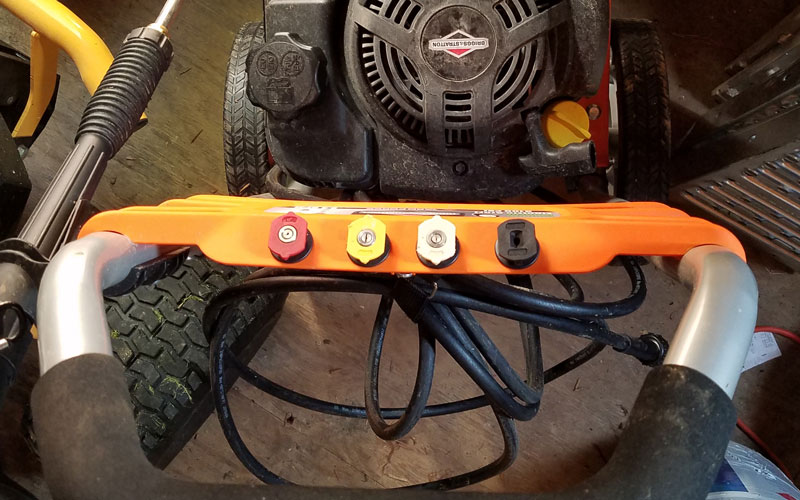
The nozzles are stored in the handle for easy access and changing
With the trigger in the LOCK position, pull in the cuff at the end of the wand tip and insert the nozzle tip into the groove. Release the cuff, and the lip will slide over the nozzle to hold it securely. You can now release the trigger LOCK. At any time, you can change out nozzle tips using the same procedure. I found myself changing nozzles frequently to get the right amount of pressure for the job at hand.
Here’s a general guide for using the colored nozzle tips:
| Color | Degree | Purpose |
| Black | – | For use with detergent only. Attaching the black nozzle automatically pulls from the detergent tray and mixes using a 20:1 water to soap ratio. |
| White | 400 | Delicate rinsing for cars, RVs, trucks, lawn equipment, etc. |
| Yellow | 150 | General purpose. Great for siding, fences, brick patios, wood decks, driveways, sidewalks, garage floors, etc. |
| Red | 00 | Hard surface cleaning for cement, metal, brick, etc. Caution: the 00 nozzle tip should not be used on wood, plastic, textiles, or vehicles since it will gouge and damage these surfaces. |
Before starting the engine, squeeze the handle on the trigger to clear out any air, soap, or debris that might be in the hose from previous use. Clear water should flow out of the end of the nozzle.
With the faucet opened and the hose cleared, select the best nozzle tip for your project (see above).
Two Ways to Start the Engine
Now you can start the engine. You have two options: (1) pull the starter cord, or (2) use the key fob. Guess which one I used most?!
Both options offer an easy start with no priming. I don’t believe I’ve ever tested a tool like this pressure washer that started on the very first pull. I tested the pull cord on five occasions, and the engine caught on the first pull each time. The S2 Starting Guarantee did not disappoint.
But since the tool is equipped with the wireless key fob start, I quickly fell in love with this option. Once the fob is synched with the button in the battery compartment, simply push the START button on the fob. The engine comes to life. I tested the fob out to 100 feet. I never had a failed start/stop even at that distance.
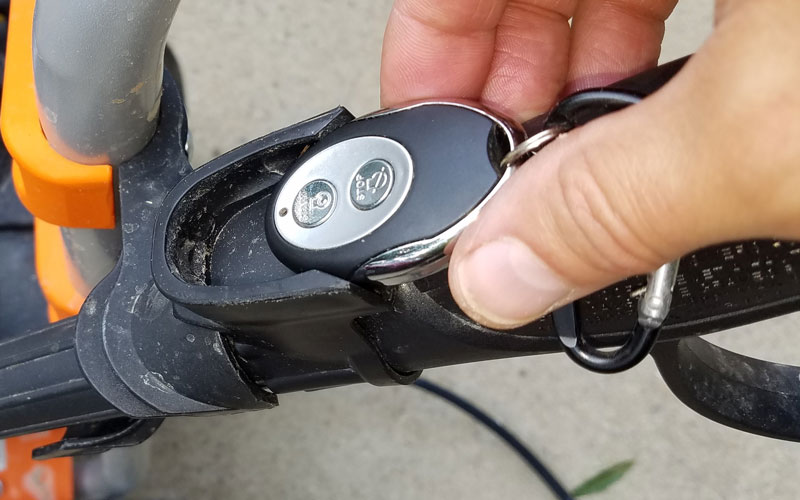
The fob stores snuggly in the soft plastic sleeve on the handle, or you can use the included carabiner to clip to a belt loop
With the engine running, squeeze the trigger to engage the pressure washer. You will hear the pump cycle on as it powers the hose. At first, I was a bit surprised at the amount of “kick” from the wand when I depressed the trigger. I’m not saying that it kicked like a 12 gauge shotgun, but I was glad that I didn’t attempt to squeeze the trigger for the first time when I was atop a ladder. It might have blown me off!
Testing the Pressure Washer
I tested this unit over a four week period in temperatures ranging from 800F—950F.
I didn’t so much design a rigorous series of tests for the pressure washer to accomplish as much as I just looked around my property. I found a 20-year old neglected redwood playground set, a heavily-trafficked walkway to my house, a deeply-stained concrete patio, an outbuilding, a weathered section of fence, and a couple of dirty cars that begged to be cleaned.
Battery Life
I never experienced a problem with the unit starting with a charged battery or using the pull cord. When the battery drained, the engine did not turn over. A quick recharge of the battery and that problem was solved. The battery lasted for about 70 start/stop cycles before I recharged. I lost exact count, but I know it made it to at least 65 starts. Based on the tasks I used the pressure washer to achieve, the battery charge lasted from 3 days to a week. Obviously, the more you stop and start the unit via the remote, the faster the battery drains.
Cleaning Wood Surfaces
Attaching the 150 nozzle, I took smooth, steady passes at the redwood playground set. Years of mold, mildew, and pollen disappeared quickly. The key to working a pressure washer on wood is to keep the nozzle tip at a safe distance (usually 12-16 inches) and to move quickly enough so as not to rip into the wood surface, which is especially important once the wood gets softer from heavy soaking.
On a couple of sections of heavily stained wood, I added TSP (trisodium phosphate) to the pressure washer dispensing tank and switched to the BLACK nozzle. After spraying on the cleaner, I switched off the unit for 10 minutes while the TSP did its work. Then I switched to the 400 nozzle, squeezed the trigger while pointing away from any nearby objects to clean out the hose, and then rinsed away the TSP. The wood came clean.
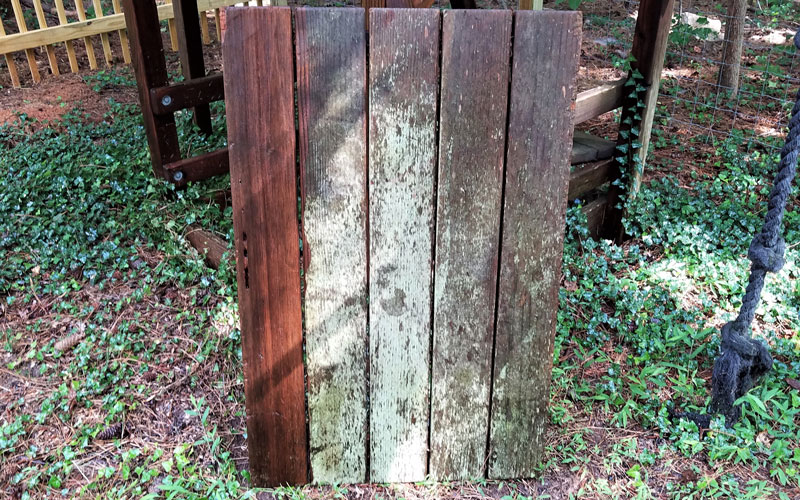
Treated and rinsed wood on the left
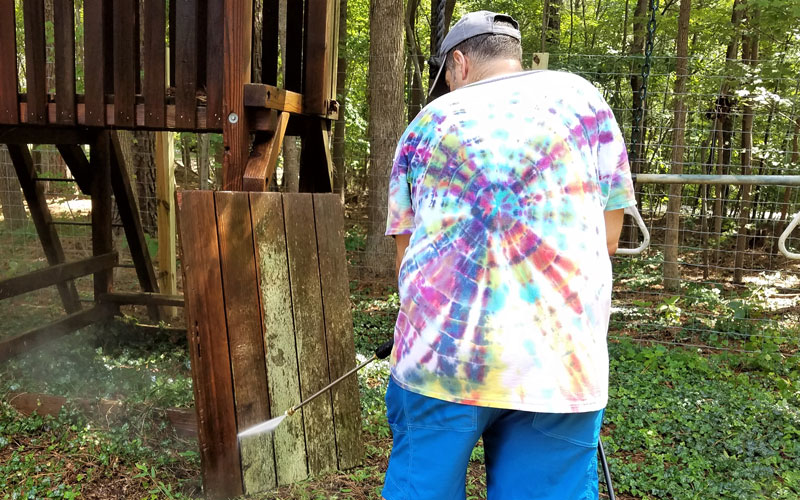
The pressure washer removed 20 years of filth like magic
As I gained experience with which nozzle tip to use and the amount of kick from the pressure washer running at full stream, I tried working from a ladder to clean hard-to-reach places.
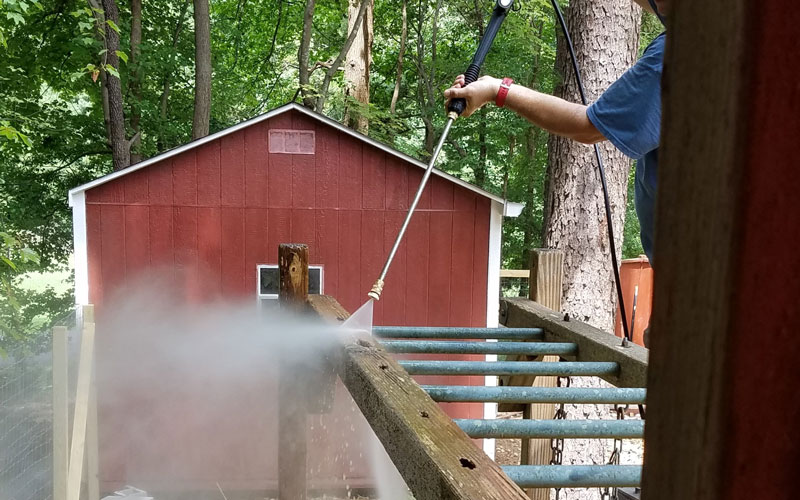
Once I got the hang of it, I felt comfortable working from a ladder, starting the unit remotely once I was standing securely in place
The pressure washer had no problem removing built-up pollen from my shed and fences, either.
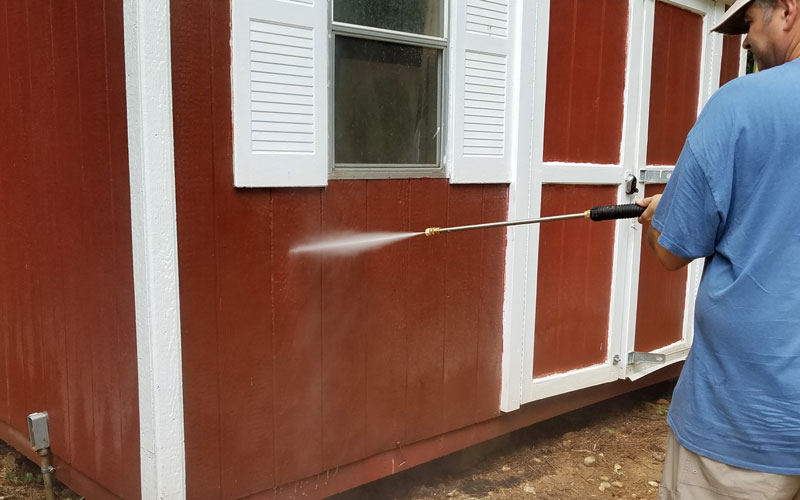
Pollen lost its reign over my shed and fence
As far as cleaning wood, this tool made old things look new.
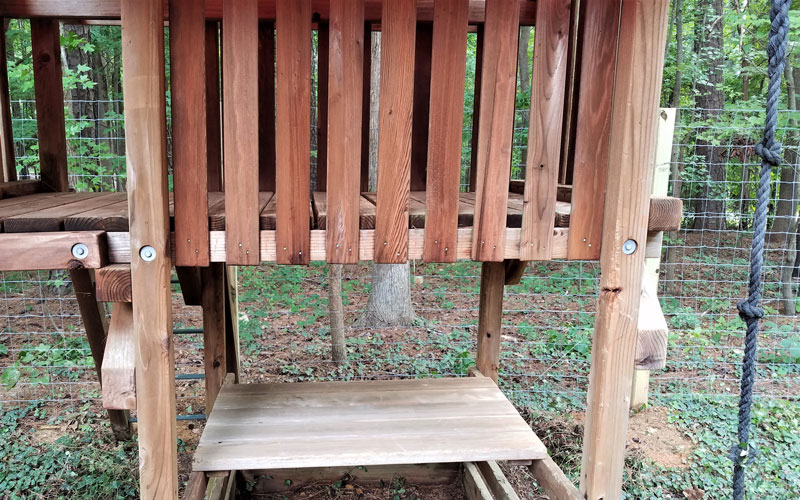
The redwood looked like new in no time
Cleaning Hard Plastic
Out of curiosity, I turned the pressure washer on the hard plastic slide that had years of filth etched into its pores.
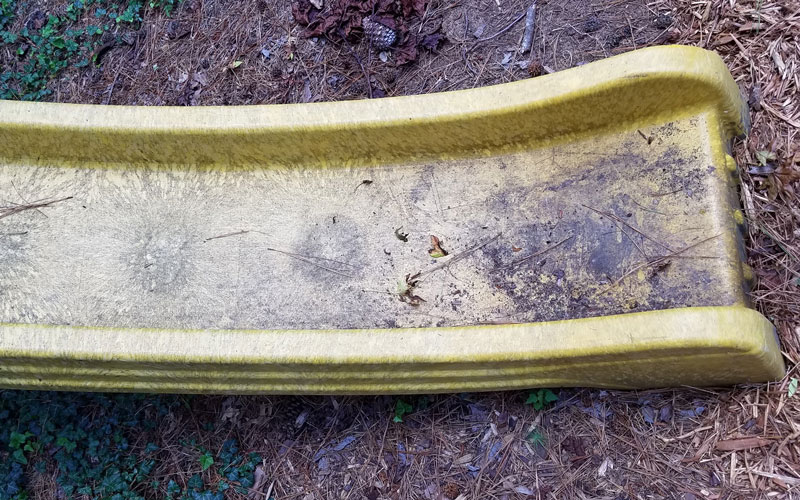
Before on hard plastic
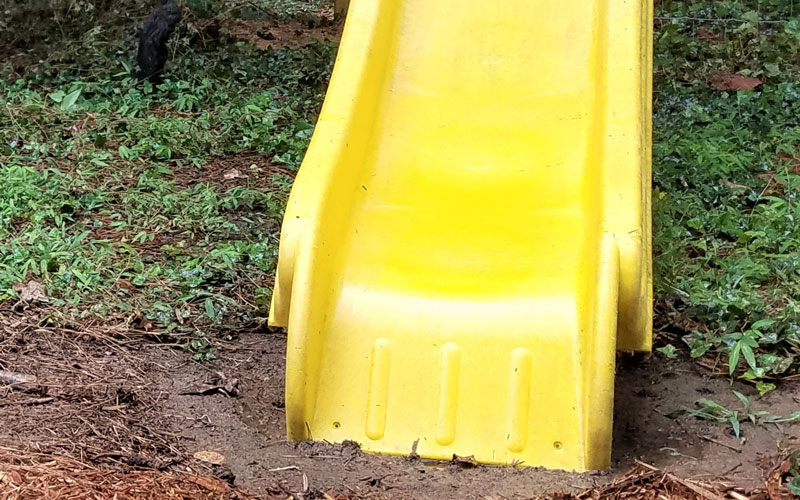
After on hard plastic
Next, I wondered if the pressure washer could clean off the soft plastic tarp material that serves as a roof for the playhouse. Yup, it worked like a charm.
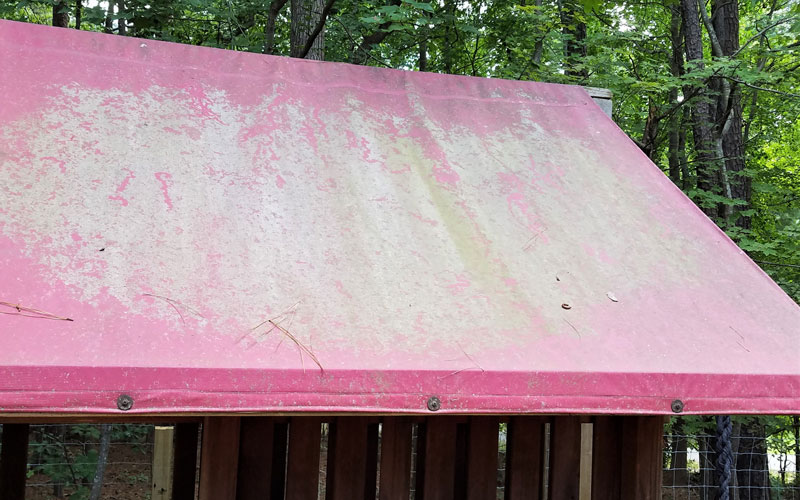
Before on soft plastic
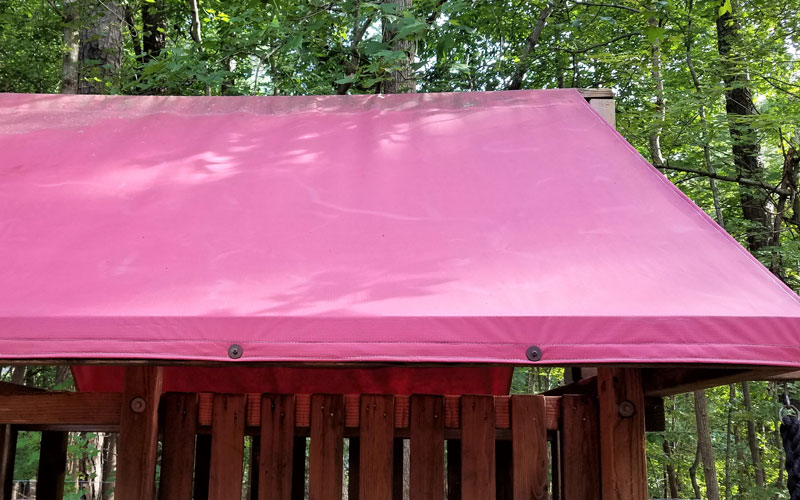
After on soft plastic
Finally, I shot a few streams of water at the basin of two plastic bird baths that are algae prone. In seconds, the bowls were like they just came out of the box. Prior to this, it would take me 10 minutes to clean each bird bath using a scrub brush, hot water, and soap. The concentrated force of the water did this in the blink of an eye.
By fighting the temptation to get the nozzle close enough to shred these surfaces I wanted to clean, the powerful pump and engine did all of the work.
Washing Cars
Needless to say, you don’t want as much power when cleaning a car with a delicate painted finish as you need on a hardened, corroded surface. I added car wash soap to the detergent dispenser, attached the black soap nozzle, and gave both of my vehicles a good soaking, starting at the bottom and working my way up.
After about 10 minutes, the 20:1 water to soap ratio softened the grime and dirt. After clearing out the soap from the hose by pointing and spraying the wand onto the driveway until the water came out sans bubbles, I rinsed the soap off the cars from the top down. With the exception of a few drops of pitch that have been on my truck for months, the cars shined. Granted, my goal when washing my cars is not to make them look new, but I did achieve my goal of making them clean and shiny with minimal effort. So…mission accomplished.

The pressure washer cleaned up my cars nicely
Cleaning Concrete and Brick
Some porous materials, like concrete, tend to soak up tannins more readily than others. Given the high heat and humidity, billions of falling, rotting leaves, and frequent heavy rains, organic materials break down quickly here in North Carolina. That quickly turns concrete surfaces and the brick on the lower section of homes into an unsightly, dark mess.
Brick is a special animal; you want to clean the brick without loosening the mortar holding the bricks together. Using the 150 nozzle at about 14 inches, a relatively slow left to right movement of the wand while squeezing the trigger restored brick to looking like new while cleaning—and not removing—the mortar.
Concrete surfaces like driveways, patios, and walkways are a different challenge mainly because they are HUGE. Using the 00 nozzle tip, I cleaned two patios, an eight section walkway, and ¼ of my concrete driveway over the course of a couple of days.

Heavily-stained concrete takes a little more time to clean, but the 0-degree nozzle works wonders
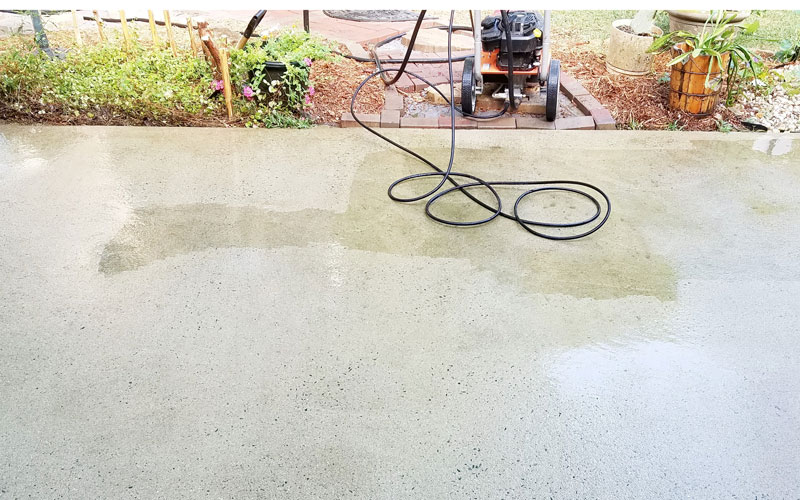
You can really see the contrast between clean and not-yet clean

Once your concrete is clean, you can dye, stain and or seal the surface for a long-lasting finish that will greatly reduce the time you spend cleaning in future
Ergonomic Design
While this is the most state-of-the-art pressure washer on the market today, if you use it for several days in a row, you’re going to get a cramp in your hand! The trigger is ergonomic and fits naturally in your hand. But using any tool in a repetitive position for hours on end is going to leave a mark.
After about 10 hours of use, my hand felt like a claw. Using the washer on vertical wood surfaces required relatively quick, precise, steady motions of the hand and arm. Switching to horizontal concrete surfaces on the sidewalk and patio allowed my arm to point at a natural, downward angle, but the slower pace required made me to take breaks every hour or so to get blood flowing back into my arm and hand.
Unless you plan to use this tool commercially, you are not going to put as many hours on it as I did in such a compressed period of time. So it is doubtful that you will feel the same discomfort I did in my testing. We do rigorous testing at GPR, putting it through more extreme tests than all but the most serious gardeners. Finding any breaking point, weak spot, or just a nature-of-the-beast tendency of a tool doesn’t necessarily happen in a one hour test. We log hours on tools before we write a review.
In the case of the Yard Force pressure washer, I logged more than 30 hours of runtime on the engine during testing. The tool started reliably each time, and the dipstick never moved from FULL to LOW in those hours of use.
Did the Yard Force Gas Pressure Washer Work Well?
Short answer: Hell yes.
I’m of the generation that gets much more personal satisfaction from extending the life of the things I own while making them look like new than I do from purchasing new things. I loved that I could take old, decrepit-looking surfaces and transform them into something like new. The pressure washer worked like a giant eraser, taking years off each surface I cleaned. If not for safety concerns, I would almost want to test this on my body to see if it could make me look like I’m 20 years old again.
Here’s what I loved about the Yard Force YF3100ES-R pressure washer:
- Easy to use. The machine is light enough and has big enough rear wheels to take it anywhere. I had no problem lifting it in and out of my shed without using a ramp. The 25’ hose allowed me to move to the surface I wanted to clean without having to reposition the entire unit. The wide-mouth gas tank prevented spills when filling up, and oversized soap dispenser allowed me to soap down large areas without needing to refill. The wand fits naturally in my hand (medium to large-sized hands), and the trigger/nozzle tip alignment made it feel like an extension of my hand when pointing it. It also has convenient nozzle storage, a hose attachment strap, and a built-in wand holder with molded remote fob holder.
- Innovative. I loved the convenient placement of the nozzle tips, built-in wand holder, and hose attachment strap. And of course, I loved the wireless remote starter fob as well as the molded storage area for it so it never gets misplaced.
- Durable. This baby is built to last with heavy-duty hoses, a solid frame, and sturdy wheels.
- Powerful. The latest Briggs & Stratton 875EXi SeriesTM is a single cylinder, 4-stroke, air-cooled, OHV (Overhead Valve) engine with 190cc displacement and is a vast improvement over previous iterations. It generates 3100 PSI! Enough said.
- Replacement parts. Yard Force offers replacement parts (hoses, gaskets, etc.) and Briggs & Stratton offers replacement air filters, spark plugs, etc. when the time comes to replace parts. If you opt to use a 100’ pressure washer hose, you gain even greater range from the faucet to the worksite.
As far as criticisms or suggestions, I’ll offer just one:
- Long term storage. This “criticism” goes for all pressure washers. You need to treat the pump with Pump Saver for long term storage if the unit will be exposed to freezing temperatures. Guess what killed the pump in my electric pressure washer? Forgetting to add Pump Saver over the winter. I would LOVE to see a pressure washer pump that can be drained easily for winter storage. I can remember to put in fuel stabilizer or to run the tank empty. Since pressure washers are the only tool I own with a pump, I wish I could protect the pump by simply draining it via a switch or plug.
Warranty
Yard Force stands behind its Yard Force Gas Pressure Washer (YF3100ES-R) with a 2-year warranty on the pump and engine. It also covers 90-days on all accessories.
Recommendation
If you have many surfaces to clean and require some serious power, I would absolutely recommend the YF3100ES-R. If you require less power or have smaller areas to clean, Yard Force has less expensive (and less powerful) tools that you should consider, including a myriad of electric options.
Where To Buy
No products found.
Last update on 2024-04-19 / Affiliate links / Images from Amazon Product Advertising API
Enjoyed This Review?
If you liked this review, please sign up for our email updates with reviews, how-to articles and gardening videos!

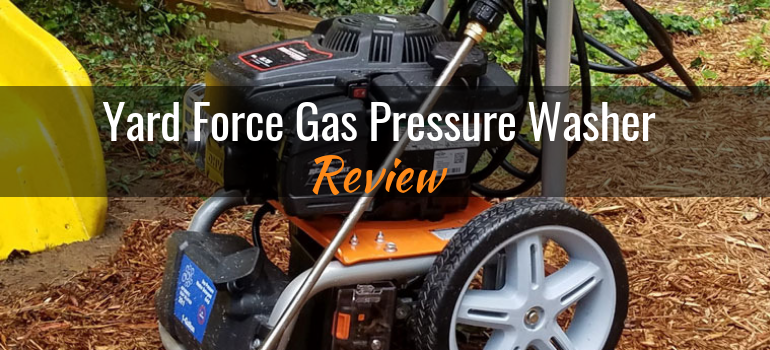

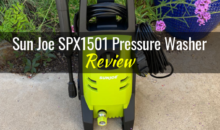
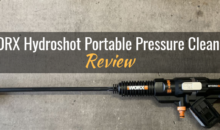

can you run this washer without the battery? Like a standard lawnmower without a battery?